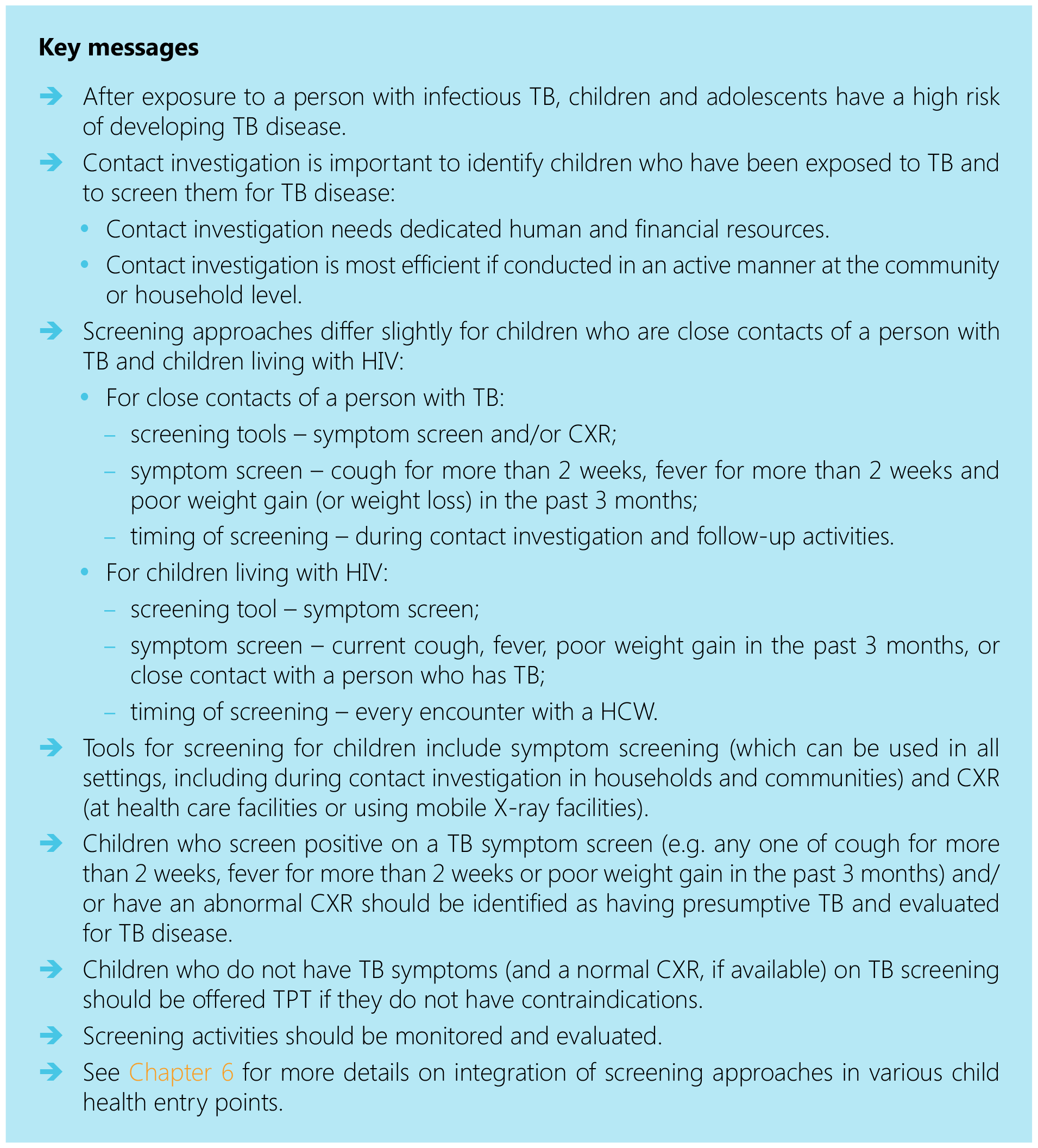Children and Adolescents
2.4.4. Screening of adolescents living with HIV
As highlighted in Box 2.7, systematic screening for TB disease should be conducted among adolescents living with HIV using the WHO-recommended four-symptom screen (W4SS). Those who report any one of the symptoms of current cough, fever, weight loss or night sweats may have TB and should be evaluated for TB and other diseases. Adolescents living with HIV may also be screened using CRP (using a cut-off of >5 mg/L), CXR or mWRDs.
2.4.3. Considerations for implementation
Children living with HIV should be followed up closely in the health care system. Those living in high TB incidence settings should be screened for TB at every contact with the health care system. Given the high risk of progression to TB disease and the high mortality rate, combined symptom screening should also be done at every contact with the health care system, including events such as vaccination days, maternal health appointments, nutritional screening and food support programme visits.
2.4.2. Other screening tests
There are currently inadequate data to extrapolate use of CXR, point-of-care C-reactive protein (CRP)-based TB screening or mWRDs as screening tests in adults to children aged under 10 years living with HIV. CXR can be used for screening children living with HIV who are close contacts of people with infectious TB (see Section 2.3.1). Tests for TB infection such as IGRA are not useful for TB screening.
2.4 Screening children and adolescents living with HIV
Children living with HIV have a high risk of rapid progression to severe disease and death if a diagnosis of TB is missed. A child living with HIV is 3.5 times more likely to progress to TB disease than a child who is HIV-negative (29). The risk, although greatly reduced, remains elevated in children on antiretroviral therapy (ART). An estimated 10% of paediatric deaths from TB are among children living with HIV, with 21 000 deaths annually (1).
2.3.2. Considerations for implementation of screening of child close contacts
Once the contacts of a person with TB have been identified, the contacts should be screened for TB symptoms and/or undergo CXR, followed by appropriate diagnostic evaluation (15, 28). Contact investigation can be expensive and time-consuming for HCWs. Additionally, TB is a highly stigmatized disease in some settings, and the visit of a health worker to a person’s home may risk discrimination against the household.
2.3.1.4. Tests for TB infection
As in adults, TST and IGRA should not be used to screen for TB disease in children (26, 27), as these tests cannot distinguish TB infection from TB disease and cannot predict who will progress to TB disease. Both tests provide a marker of TB infection but may be influenced by mechanisms unrelated to TB infection and give false-negative or false-positive results. The role of these tests in decisionmaking for TPT and in the diagnostic evaluation of children with presumptive TB is discussed in
2.3.1.3. Molecular WHO-recommended rapid diagnostic tests
mWRDs are not currently recommended for screening for TB disease in children and young adolescents aged under 15 years, but they should be used to diagnose TB in children who screen positive using a symptom screen or CXR (see Chapter 4).
2.2.3 Key implementation steps in contact investigation
In addition to planning and budgeting, NTPs should consider the following key implementation steps in contact investigation:
Pagination
- Previous page
- Page 13
- Next page

 Feedback
Feedback
